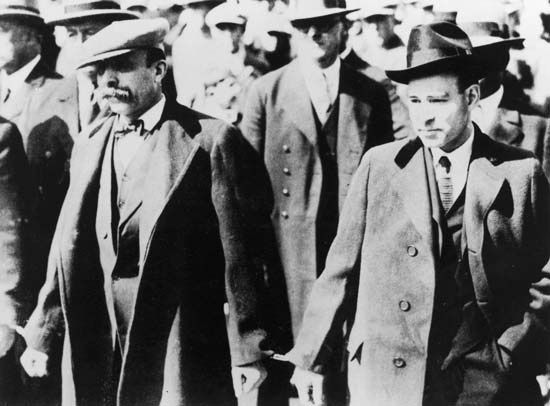Sacco-Vanzetti case
United States law case
 controversial murder trial in Massachusetts, U.S., extending over seven years, 1920–27, and resulting in the execution of the defendants, Nicola Sacco and Bartolomeo Vanzetti.
controversial murder trial in Massachusetts, U.S., extending over seven years, 1920–27, and resulting in the execution of the defendants, Nicola Sacco and Bartolomeo Vanzetti.The trial resulted from the murders in South Braintree, Massachusetts, on April 15, 1920, of F.A. Parmenter, paymaster of a shoe factory, and Alessandro Berardelli, the guard accompanying him, in order to secure the payroll that they were carrying. On May 5 Sacco and Vanzetti, two Italian anarchists who had immigrated to the United States in 1908, one a shoemaker and the other a fish peddler, were arrested for the crime. On May 31, 1921, they were brought to trial before Judge Webster Thayer of the Massachusetts Superior Court, and on July 14 both were found guilty by verdict of the jury. Socialists and radicals protested the men's innocence. Many people felt that the trial had been less than fair and that the defendants had been convicted for their radical, anarchist beliefs rather than for the crime for which they had been tried. All attempts for retrial on the ground of false identification failed. On November 18, 1925, Celestino Madeiros, then under a sentence for murder, confessed that he had participated in the crime with the Joe Morelli gang. The state Supreme Court refused to upset the verdict, because at that time the trial judge had the final power to reopen on the ground of additional evidence. The two men were sentenced to death on April 9, 1927.
A storm of protest arose with mass meetings throughout the nation. Governor Alvan T. Fuller appointed an independent advisory committee consisting of President A. Lawrence Lowell of Harvard University, President Samuel W. Stratton of the Massachusetts Institute of Technology, and Robert Grant, a former judge. On August 3, 1927, the governor refused to exercise his power of clemency; his advisory committee agreed with this stand. Demonstrations proceeded in many cities throughout the world, and bombs were set off in New York City and Philadelphia. Sacco and Vanzetti, still maintaining their innocence, were executed on August 23, 1927.
Opinion has remained divided on whether Sacco and Vanzetti were guilty as charged or whether they were innocent victims of a prejudiced legal system and a mishandled trial. Some writers have claimed that Sacco was guilty but that Vanzetti was innocent. Many historians believe, however, that the two men should have been granted a second trial in view of their trial's significant defects.
On the 50th anniversary of their deaths in 1977, the governor of Massachusetts, Michael S. Dukakis (Dukakis, Michael S.), issued a proclamation stating that Sacco and Vanzetti had not been treated justly and that no stigma should be associated with their names.
Additional Reading
Katherine Anne Porter, The Never-Ending Wrong (1977), was written by an eyewitness. Roberta Strauss Feuerlicht, Justice Crucified (1977), examines the case in the context of the immigrant experience. Francis Russell, Sacco & Vanzetti (1986), concludes that Sacco, at least, was guilty. William Young and David E. Kaiser, Postmortem: New Evidence in the Case of Sacco and Vanzetti (1985), reasserts their innocence.